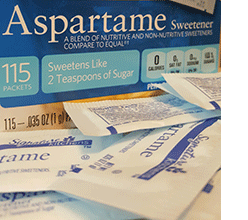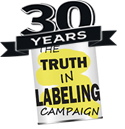MSG
Manufactured vs Natural Glutamic Acid
Ingredient Names Used to Hide MfG

Excitotoxins
Before 1969, the world knew nothing of excitotoxins because no one had noticed them. But in 1969 all that changed, and the existence of toxic amino acids became the best-guarded secret of the food and drug industries.
Today excitotoxins remain largely ignored or unknown because the rich and powerful food and pharmaceutical industries want it that way. Because a great deal of food industry profit depends on substituting cheap excitotoxins for real food. And a great deal of pharmaceutical industry profit depends on selling pharmaceuticals to “cure” the disease and disability caused by food-based excitotoxins.
What are excitotoxins?
Excitotoxins are amino acids with particular characteristics. (Not all amino acids are excitotoxins.) The ones in which we are immediately interested are glutamic acid (glutamate) and aspartic acid (aspartate), amino acids commonly added to processed food.Amino acids are the building blocks of protein. Amino acids are what proteins are made of.
Some amino acids function as neurotransmitters. Neurotransmitters carry nerve impulses from one nerve to another and to non-nerve cells. They are the brain chemicals that move information from one cell to another.
Neurotransmitters are either excitatory or inhibitory. Glutamic acid and aspartic acid are excitatory neurotransmitters -- exciting the cells with which they communicate. Glutamic acid is the most common excitatory neurotransmitter in the central nervous system.
Under certain circumstances, an excitatory neurotransmitter, or group of excitatory neurotransmitters, will fire repeatedly, over-stimulating their receptor cells until their receptor cells die. The neurotransmitter that over-stimulates its receptor cells is referred to as an excitotoxic neurotransmitter, and the resulting condition is referred to as excitotoxicity. Neurotransmitters are called excitotoxic when they over-stimulate their receptor cells to the point of killing them.
Excessive glutamic acid and aspartic acid can over-stimulate the brain and lead to excitotoxicity. Excitotoxicity has been implicated in certain chronic diseases including ischemic stroke, epilepsy, amyotrophic lateral sclerosis, Alzheimer's disease, Huntington disease, and Parkinson's disease.
The term “excitotoxin” was coined in 1969 by Dr. John Olney after he observed that glutamic acid fed to laboratory animals killed brain cells and subsequently caused gross obesity. As an excitotoxin, glutamic acid over-stimulates brain cells and cells outside of the central nervous system to the point of killing them.
Glutamic acid excitotoxicity is the process that underlies the damage done by monosodium glutamate and the other ingredients that contain processed free glutamic acid (MSG).
Dictionary definitions of the term “excitotoxins” don’t necessarily give you the whole picture, but here are a few taken from the Internet -- accessed 8/16/2016:
The American Heritage® Dictionary of the English Language, 5th edition Copyright © 2013 by Houghton Mifflin Harcourt Publishing Company. Published by Houghton Mifflin Harcourt Publishing Company:An ex·ci·to·tox·in is ‘Any of a group of neurologically active compounds, including glutamate and aspartame, that in high concentrations have detrimental excitatory effects on the central nervous system and may cause injury to nerve cells.’
Real Food whole Health:
“An excitotoxin is a chemical that causes a brain cell to become overexcited and fire uncontrollably, leading to cell death. MSG (and other excitotoxins like asparatame) has the potential for inflicting permanent damage to the brain and nervous system. These chemicals also cross the pacental barrier, harming the brains of unborn children.”
Farlex Partner Medical Dictionary © Farlex 2012:
excitotoxicity (ek-sī'tō-tok-sis'i-tē), “Neuronal death resulting from increased intracellular glutamate; neuronal ischemia leads to ATP loss and depolarization, with glutamate release from synapses, and subsequent overstimulation leading to sodium and calcium ion gate porosity.”
McGraw-Hill Concise Dictionary of Modern Medicine. © 2002 by The McGraw-Hill Companies, Inc.:
excitotoxicity Neurology “Neuronal injury caused by excessive release of excitatory neurotransmitters–glutamate and aspartate causing damage to nerve and glial cells, which occurs in diverse neurologic diseases that may be acute–eg hypoglycemia, seizures, stroke, or trauma or chronic neurodegenerative disease–eg AIDS-dementia complex, amyotrophic lateral sclerosis, Huntington's disease, and possibly Alzheimer's disease”
Saunders Comprehensive Veterinary Dictionary, 3 ed. © 2007 Elsevier, Inc.:
excitotoxicity “exaggerated and continuous stimulation by a neurotransmitter, especially in those neuronal systems which use glutamate as the transmitter.”
According to Dr. Edward Group, the 6 most dangerous excitotoxins are:
1. MSG (Monosodium Glutamate)[Editor’s note. From the text below you will observe that Dr. Group is talking about processed free dietary glutamate regardless of the ingredient in which it is found – not just monosodium glutamate.]
This salt form of glutamate, or glutamic acid, has been known to trigger headaches for decades. Glutamate easily crosses the blood-brain barrier, stimulating cell receptors that triggers cell death [1]. While the body naturally produces glutamate when needed to trigger cell termination, flooding the body with dietary glutamate can seriously disrupt normal cellular function, especially in the brain. Avoid foods with MSG, but don’t think food is MSG-free just because you don’t see the words “monosodium glutamate" in the ingredients list [2]. MSG will also be found in ingredients with the names:
Natural flavor(s)
Flavoring
Hydrolyzed vegetable protein
Autolyzed protein
Plant Protein
Textured Protein
Yeast extract
Nutritional yeast
Carrageenan
Anything with glutamate
2. Aspartate
Aspartate, or aspartic acid, acts very similarly to glutamate [3]. This non-essential amino acid triggers NMDA receptors in cells, another of the cellular receptors used to initiate cell death. Most humans receive aspartate through consuming aspartame, an artificial sweetener often hidden in many processed foods. It has been linked with serious neurological effects such as headaches, sleep disorders, and seizures [4].
3. Domoic Acid
Another non-essential amino acid, domoic acid occurs naturally in shellfish. Excessive overconsumption has shown to lead to the development of epilepsy, especially in the elderly. [5]. If you’re a seafood eater, pick wild-caught varieties of fish like salmon, trout, and tuna. This way you are receiving your omega-3 fatty acids without the excitotoxins and pollutants common in shellfish and farm-raised seafood.
4. L-BOAA
Also known as ODAP, this protein is another excitotoxin that behaves in similar fashion as glutamate. It naturally occurs in the grass pea and similar plant species. Overexposure to grass pea and L-BOAA leads to neurolathyrism, a disorder that affects motor skills and movement and can lead to paralysis [6].
5. Cysteine
Industrially created by hydrolysis of human hair and poultry feathers, this excitotoxin is important for artificial flavor creation. It reacts with sugars in a process known as the Maillardreaction, resulting in meaty and savory flavors. High cysteine levels are associated with Parkinson’s and Alzheimer’s disease [7].
6. Casein
This protein compound occurs in cheese at naturally high levels. 20% of casein is glutamic acid which makes for a tasty treat; however, it also increases glutamate overload. Casein is often used by food producers to improve flavor, although it is also frequently used to increase protein levels in fitness products.
References:
1 Olney JW. Excitotoxins in foods. Neurotoxicology. 1994 Fall;15(3):535-44.
2 Scopp AL. MSG and hydrolyzed vegetable protein induced headache: review and case studies. Headache. 1991 Feb;31(2):107-10.
3 Chen PE, Geballe MT, Stansfeld PJ, Johnston AR, Yuan H, Jacob AL, Snyder JP, Traynelis SF, Wyllie DJ. Structural features of the glutamate binding site in recombinant NR1/NR2A N-methyl-D-aspartate receptors determined by site-directed mutagenesis and molecular modeling. Mol Pharmacol. 2005 May;67(5):1470-84.
4 Humphries P, Pretorius E, Naud H. Direct and indirect cellular effects of aspartame on the brain. Eur J Clin Nutr. 2008 Apr;62(4):451-62.
5 Andermann F, Carpenter S, Zatorre RJ, Cashman NR. Temporal lobe epilepsy caused by domoic acid intoxication: evidence for glutamate receptor-mediated excitotoxicity in humans. Ann Neurol. 1995 Jan;37(1):123-6.
6 Knig G, Hartmann J, Krause F, Deckert J, Heinsen H, Ransmayr G, Beckmann H, Riederer P. Regional differences in the interaction of the excitotoxins domoate and L-beta-oxalyl-amino-alanine with [3H]kainate binding sites in human hippocampus. Neurosci Lett. 1995 Mar 3;187(2):107-10.
7 Parsons RB, Waring RH, Ramsden DB, Williams AC. In vitro effect of the cysteine metabolites homocysteic acid, homocysteine and cysteic acid upon human neuronal cell lines. Neurotoxicology. 1998 Aug-Oct;19(4-5):599-603.
8 Global Healing Center, The 6 Most Dangerous Excitotoxins, Dr. Edward Group DC, NP, DACBN, DCBCN, DABFM (accessed 8/20/2016)
The excitotoxic components of processed free glutamic acid (MSG) are very special agents -- because they are often purposely added to food, cosmetics, pharmaceuticals, and dietary supplements for the sole purpose of lining the pockets of those who manufacture and sell them.
We know very little about the excitotoxic amino acids. Amino acids are chemicals found in nature. We know that. But arsenic, hydrochloric acid, and viruses are also found in nature, and we’re not forced to eat them or wash our hair with them.We know very little about the actions of excitotoxins. However, we have learned that glutamic acid (glutamate) loads on (triggers) glutamate receptors both in the central nervous system and in peripheral tissue (heart, lungs, and intestines, for example). When loading on (stimulating) a glutamate receptor, they may simply stimulate that receptor and then fade, so to speak; they may damage that receptor; or they may stimulate that receptor repeatedly (over-excite that receptor) until it dies.
There’s another possibility. It is known that there are a great many glutamate receptors in the brain. It is possible that if a few are damaged or wiped out following ingestion of MSG, their loss may not be noticed -- because there are so many undamaged glutamate receptors remaining. It is also possible that individuals differ in the numbers of glutamate receptors that they have; that people with more glutamate receptors to begin with are less likely to demonstrate brain damage following ingestion of MSG because even after some glutamate receptors are killed or damaged, there are still sufficient undamaged glutamate receptors to carry out normal functions.
Saying it another way, people with fewer receptors to begin with might be more likely to demonstrate brain damage following ingestion of MSG because they have fewer glutamate receptors remaining after MSG insult than individuals who had more glutamate receptors to begin with. That might account for some people being more sensitive to MSG than others.
Less is known about glutamate receptors outside of the brain – in the heart, stomach, and lungs, for example. But in each location there would be fewer glutamate receptors than found in the brain; and for some individuals, there might be so few receptors to begin with, that ingestion of even small amounts of MSG might trigger asthma, atrial fibrillation, or irritable bowel, for example; while indivuals with more glutamate receptors to begin with, would not notice the loss of a relatively few receptors.
Short-term effects of excitotoxic glutamate (effects like asthma and migraine headache) have long been obvious -- obvious to all those who are not directly or indirectly beholden to the financial incentives offered by the glutamate industry and their friends. Researchers have only recently begun to correlate the adverse effects of glutamate ingestion with endocrine disturbances such as reproductive disorders and gross obesity, with some psychological disorders, and with neurodegenerative disease. And a few have begun to realize the importance of glutamic acid's access to the human body through the mouth, through the nose, and through the skin.
There are 3 excitotoxic amino acids used in quantity in food, cosmetics, pharmaceuticals, and dietary supplements:
Glutamic acid (found in flavor enhancers, infant formula, enteral care products, protein powders, processed foods, anything that is hydrolyzed, and some pesticides/fertilizers),Aspartic acid (found in low-calorie sweeteners, aspartame and aliases, infant formula, protein powders, anything that is hydrolyzed), and
L-cysteine (found in dough conditioners)

